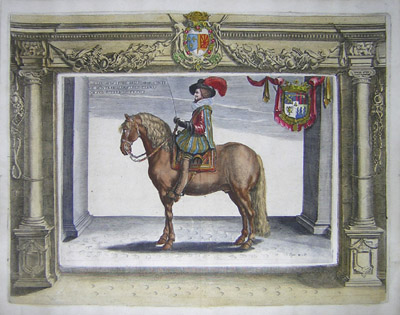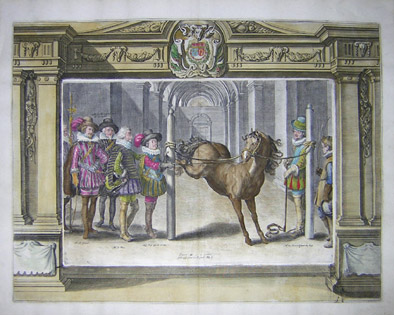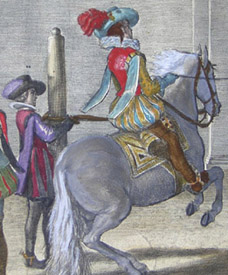Description
Antoine de Pluvinel was born in France and taken to Italy to study horsemanship from the age of 10 to about 16, when he was taken in by M. de Sourdis, the premier ecuyer (first equerry) of King Charles IX. In his early 20s, Pluvinel was appointed first equerry to the king’s brother, who soon succeeded to the throne as Henri III. His reputation grew, and when Henri IV took the throne in 1589, Pluvinel remained as a member of the court. In 1594, Pluvinel realized his dream of founding a riding school. He was at work on his book Le Manege Royal when he died. A first, incomplete edition appeared in 1623, illustrated by Crispijn de Passe. A second version, illustrated by the same artist, with improved text was issued about two years later under the title L’Instruction du Roy, en L’Exercice de Monter a Cheval and this version was translated and reissued many times. The book shows the instruction of the young Louis XIII (1601-43) who was crowned in 1610 under the regency of his mother and reigned from 1617 onward. The text and illustrations explain Pluvinel’s principles of training horses in the form of a dialogue with the king, interspersed with commentaries by M. le Grand and other distinguished authorities. Pluvinel’s book was groundbreaking in its advocacy of humane training methods, a departure from the harsher practices commonplace at the time.
Crispijn de Passe II (rendered “Crispian de Pas” in French) was a Dutch engraver, draftsman, print publisher and writer. He was the namesake of his father, who trained all four of his children as engravers. De Passe II was the most prolific of his generation, engraving biblical and historical subjects, book illustrations and portraits, including a series of four contemporary European rulers that included Emperor Rudolf II and Louis XIII of France and important images of other European kings. He also made portraits of Dutch scholars, statesmen and admirals. Some of his works were made after his own designs, including most of Hortus Floridus (1614). From 1617 he regularly worked in Paris, where his notable works included Antoine de Pluvinel’s Le Manege Royal (c. 1623-26). From 1637, he was one of group of Dutch artists who made a series of drawings from Danish history for King Christian IV, many of which are in the collection of the Prentenkabine in the State Art Museum, Copenhagen.
References:
“Crispijn (van) de Passe (ii).” The Grove Dictionary of Art. New York: Macmillan. 2000. Artnet.com. http://www.artnet.com/library/06/0656/T065688.asp (3 July 2003).
Ritter, Dr. Thomas. “Antoine de Pluvinel.” ClassicDressage.com. 9 March 2001. http://www.classicaldressage.com/articles/pluvinel.html (3 July 2003).
















